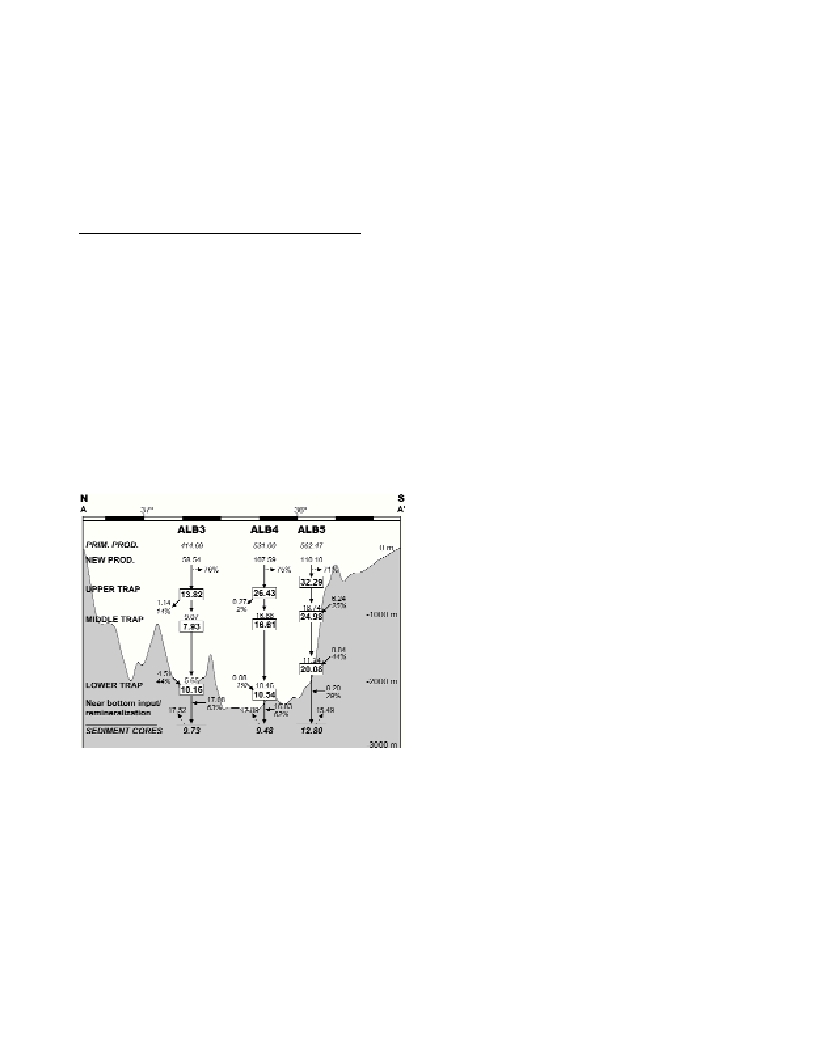Rapp. Comm. int. Mer Médit., 37,2004
240
ORGANIC CARBON BALANCE ON A NORTH-SOUTH TRANSECT
ACROSS THE EASTERN ALBORAN SEA
A. Sanchez-Vidal*, A. Calafat, M. Canals, J. Frigola, J. Fabres
GRC Geociències Marines, Dept. d’Estratigrafia, Paleontologia i Geociències Marines, Universitat de Barcelona, Barcelona,
Spain - tonim@natura.geo.ub.es.
Abstract
Our study provides the first estimates of particulate organic carbon export in the Alboran Sea. A vertical organic carbon balance has been
estimated using satellite-derived primary production, organic carbon ?uxes down the water column, and mean accumulation rates in
bottom sediments. Results suggest that less than 1% of the carbon fixed during photosynthesis in surface waters is vertically transferred
and finally buried in deep sediments. A large portion is supplied by lateral advection and by shelf-derived benthic nepheloid supply.
Keywords: sediment traps, organic carbon, Alboran Sea
To know the transport of particulate organic carbon (POC) in the
oceans is crucial for the understanding of the global carbon cycle and
its response to climate change. Only a small fraction of the organic
carbon produced in the euphotic zone sinks out, reaches the deep-sea
?oor and is buried forming the sedimentary record.
We have attempted to constrain the production, transfer and burial
of POC in the Eastern Alboran Sea. Particle ?ux data were obtained
from three mooring arrays deployed during one year, from June 1997
to May 1998, following a north to south transect along 1º30’W in the
Eastern Alboran Sea [1]. Each mooring line was equipped with three
sediment traps at 500-700 m depth, 1000-1200 m depth, and 30 m
above the sea ?oor. The study was part of the European MTPII-
MATER multidisciplinary project.
By combining measurements of primary production data from [2],
algorithm-generated POC ?uxes with an adapted version of Martin’s
et al. (1987) equation, POC ?uxes measured at three sediment trap-
depths [1], and mean accumulation rates measured from sediment
cores [3], balances of carbon are presented in Figure 1.
Fig. 1. Organic carbon ?ux balance across the Eastern Alboran Sea fol-
lowing a North-South transect along 1º30’ W. Bold data within rectangles
represent measured organic carbon ?uxes by the sediment traps; data
among arrows represent inferred lateral organic carbon ?uxes. All POC
?uxes are in mg m
-2
d
-1
.
Data reveal that a 14-21% of the primary production in surface
waters is exported through the euphotic zone. There is, however, a
northwards decrease of export ?uxes that likely re?ects the advection
to the east and to the south of phytoplankton-rich water by the Atlantic
jet, as depicted by SeaWiFS images [1]. Vertical POC ?uxes down the
water column are largest in the southern site. Lateral POC ?uxes are
also higher, where inputs represent 25% and 44% of the total POC
?ux at middle and lower depths, respectively. In the northern site
ALB3 a loss that accounts for 14% of the POC is observed between
upper and middle depths, and lateral input reappears between the
middle and lower traps with an input of 44% of the organic carbon. A
strong input of POC is supposed to occur below 30 meters above
bottom at the three stations to account for the difference between what
is accumulated [3] plus remineralized [4] and what is collected at the
lower bottom trap. This accounts for up to 63% of total POC reaching
the sea ?oor. The three sediment cores below the moorings have
similar organic carbon accumulation rate, a situation that has been
attributed to the spatial homogenisation capacity of near bottom
transport [3].
Computation of the total export ratio, which is the proportion of
primary production exported from the surface layer and buried in the
sediments after arriving at the sea ?oor either vertically or advectively,
yields the following values of 2.35% (ALB3), 1.79% (ALB4) and
2.28% (ALB5). However, the primary export ratio, which is the
proportion of primary production arriving at the sea ?oor vertically, is
only 0.48%, 0.68% and 0.89% for ALB3, ALB4 and ALB5,
respectively. Therefore, only 0.5-0.9% of the carbon fixed during
photosynthesis in surface waters of the Eastern Alboran Sea is
vertically transferred and buried into the deep sediments to form the
sedimentary record. A larger carbon portion is supplied by lateral
advection at intermediate depths and by benthic nepheloid layers,
probably derived from the continental margin, which in consequence
would constitute a significant source of organic carbon to the deep
Eastern Alboran Sea.
References
[1]-Sanchez-Vidal, A., Calafat, A., Fabres, J., Canals, M., 2003.
Mesoscale circulation-controlled particle and organic carbon ?uxes below
the Almeria-Oran Front (Alboran Sea, SW Mediterranean Sea). J. Mar.
Syst.(Submitted for publication)
[2]-Garcia-Gorriz, E., Carr, M.E., 2001. Physical control of
phytoplankton distributions in the Alboran Sea: A numerical and satellite
approach. J. Geophys. Res., 106 (C8): 16795-16805.
[3]-Masqué, P., Fabres, J., Canals, M., Sanchez-Cabeza, J.A., Sanchez-
Vidal, A., Cacho, I., Calafat, A., Bruach, J.M., 2003. Accumulation rates
of major constituents of hemipelagic sediments in the deep Alboran Sea: a
centennial perspective of sedimentary dynamics. Mar. Geol.,193: 207-
233.
[4]-Bianchi, A., Calafat, A., De Wit, R., Garcin, J., Tholosan, O., Cacho,
I., Canals, M., Fabres, J., Grout, H., Masqué, P., Sanchez-Cabeza, J.A.,
Sempéré, R., 2003. Microbial activity at the deep water sediment
boundary layer in two highly productive systems in the Western
Mediterranean: the Almeria-Oran front and the Malaga upwelling.
Oceanol. Acta, 25 (6): 315-324.

